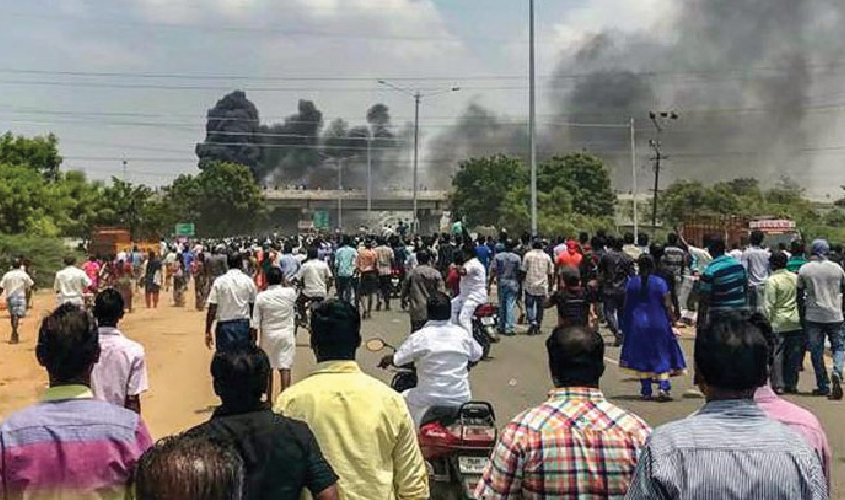The use of force by the police for crowd control—especially in situations of “unlawful assembly”—to establish the rule of law has always been a matter of debate and serious public concern. Media reports say that the protest at the copper smelting plant of Sterlite at Tuticorin in Tamil Nadu went out of hand when the police failed to control the crowd with an initial lathi-charge and resorted to firing once the latter started attacking government buildings, indulged in arson, burnt a large number of vehicles and damaged the Collectorate, which is the district level control centre of the government.
Certain groups have been opposing the existence of this Vedanta industry for several years on grounds of pollution. Decidedly, popular opinion appeared to be against the plant’s expansion, which was anyway not allowed by the authorities, giving very strong reasons for the NGO-led protesters to oppose this. Without going into the developments that led to a situation where an estimated crowd of 20,000 had to be stopped at any cost by the authorities, firing at a crowd is always the last resort.
It appears that the DM (district magistrate) and the SP (superintendent of police) could not visualise the situation’s seriousness. On hind-sight, it appears that there was some lack of imagination and unpreparedness for the occasion and failure to take timely and appropriate action.
During my police career, I personally led my force to confront violent crowds numbering between a couple of hundreds to 20,000 to 30,000. In my experience, the method to crowd control differs from place to place, situation to situation, depending on the issues and on the background in each case. There is never a thumb rule or one common solution or formula to control a crowd.
Objectively speaking, in Tuticorin, when to control a crowd of 20,000, the police had a force numbering between 1,000 and 2,000, it is not that the police was badly outnumbered.
Normally, when there is a determined police force and capable leaders and decision making authorities like the DM and SP, who are directly in the picture, it is be possible to convince a crowd not to reach a “do-or-die” stage. The crowd was reportedly agitating in the premises of a particular school where they had been directed to stay put since they had not been permitted to demonstrate near the Collectorate. Such a decision can prove to be an igniting factor, so negotiations could have been carried out sensing the public mood, which obviously appeared against the plant’s expansion, and discussions could have been prolonged tactfully.
As a diehard believer in community policing and knowing full-well that if a police leader is not able to build bridges by identifying at least some supporters among the agitators, even a small crowd may create serious problems. Looking at the manner in which the day-long developments took place, climaxing into the firing that led to 10 deaths, and subsequently two more, it’s obvious that the administration failed to control the situation.
Since a judicial inquiry has been ordered and presumably the High Court will be able to find the truth and correctly analyse the circumstances that led to the firing and whether the quantum of force was appropriately used, a decisive view may be given. The Tamil Nadu police, to my knowledge, has an excellent track record in the application of modern and effective methods and innovative techniques, both in the investigation of crimes and maintenance of law and order. I have had many opportunities to interact with some of the most competent police officers doing highly innovative work in this state and generally being successful in controlling such situations without much criticism, unlike in many other parts of the country where the police remains archaic and feudal. However reading media reports, I am somewhat surprised that the district administration and the police were not prepared to face the given situation in Tuticorin, which to my mind was not so complicated since it was long drawn out and there was no immediate provocation. There was a legitimate, growing and simmering discontent and a public agitation was going on. All this should have given many signals to the district administration to prepare for any eventuality. They could have organised much better and effective riot-controlling devices and applied the same such as rubber bullets and water-jets and deployed anti-riot vehicles like Vajra with gadgets to control the crowd.
While the crowd was moving towards the Collectorate, they could have been dispersed through the use of rubber bullets and water, which would have had much less lethal effect and would not have caused any casualties. It is also not clear if the district administration and the police, apart from being unprepared, were working in tandem at all.
It is also surprising that following the ten deaths and hugely adverse reactions from across the country, the administration failed to control the situation, which resulted in two more deaths on account of law and order going astray. For the Tamil Nadu police, Tuticorin was a wake-up call and an opportunity to get into deeper introspection and perhaps revive their lost glory, leadership and innovative ways of policing.
Amod K. Kanth is a retired police officer

